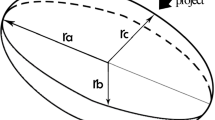Abstract
The frequency domain information of ore multi-scale image is difficult to distinguish boundary and texture details of ore objects, and hard to apply to particle size detection. Particle size classification model based on Bi-dimensional empirical mode decomposition (BEMD) is proposed, which is applied to particle detection of multi-size scenarios. Different size fraction ore images’ local frequencies are extracted by BEMD reflecting the edge and texture features. The instantaneous frequencies of each high-frequency images are statistic with image multivariate multiscale entropy, and the entropy ranges can be mapped into the particle size distribution. Three different size fraction images are used to verify the accuracy of the proposed method. The experimental results show that the validity and accuracy of our proposed model is better than other methods in multi-scenario ore particle size detection.

















Similar content being viewed by others
References
Abhik M, Debashish C, Kousik B, Arpan H (2017) Development of a mass model in estimating weight-wise particle size distribution using digital image processing. Int J Min Sci Technol 27:435–443
Anna Linderhed (2009) Image empirical mode decomposition:a new tool for image processing. Adv Adapt Data Anal 1:265–294
Artyom M (2015) Grigoryan. Fourier transforms with rotations on circles or ellipses in signal and image processing.IS&T/SPIE Electronic Imaging. Int Soc Opt Photo
Bhattacharya A, Choudhury D, Dey D (2018) Edge-enhanced bi-dimensional empirical mode decomposition-based emotion recognition using fusion of feature set. Soft Comput 22:888–903
Chen Z, Luo S, Xie T et al (2014) A novel infrared small target detection method based on BEMD and local inverse entropy. Infrared Phys Technol 66:114–124
Facco P, Santomaso AC, Barolo M (2017) Artificial vision system for particle size characterization from bulk materials. Chem Eng Sci 164:246–257
Guaragnella C, Manni A, Palumbo F et al. (2010) Bidimensional Empirical Mode Decomposition for Biometric Analysis and Iris Recognition. Comput Intel Measure Syst Appl 30–33
Huang NE, Shen Z, Long SR et al (1998) The empirical mode decomposition and the Hilbert spectrum for nonlinear and nonstationary time series analysis. Proc R Soc Lond 454(1):903–995
Huang NE, Wu ZH, Long SR (2009) On Instantaneous Frequency. Adv Adapt Data Anal 1:177–229
Huang Y, Huang Y et al (2017) Noncontact measurement and detection of instantaneous seismic attributes based on complementary ensemble empirical mode decomposition. Energies 10
Lindeberg T (1996) Scale-space: a framework for handling image structures at multiplescales. Cern Eur Organ Nucl Res-Rep-Cern:27–38
Menga Y, Zhang Z, Yina H, Ma T (2018) Automatic detection of particle size distribution by image analysis based on local adaptive canny edge detection and modified circular Hough transform. Micron 106:34–41
Mondal A, Banerjee P (2018) Hong Tang.A novel feature extraction technique for pulmonary sound analysis based on EMD. Comput Methods Prog Biomed 159:199–209
Nunes JC (2003) Y. Bouaoune,et al.Image analysis by bidimensional empirical mode decomposition. Image Vis Comput 21:1019–1026
Pajares G, de la Cruz JM (2004) A wavelet-based image fusion tutorial. Pattern Recogn 37(9):1855–1872
Qin X, Hu G, Hu K (2018) Image fusion method based on regional feature and improved bidimensional empirical mode decomposition. J Electron Imaging 27
Rajendra Acharya U, Koh JEW, Hagiwara Y (2018) Automated diagnosis of focal liver lesions using bidirectional empirical mode decomposition features. Comput Biol Med 94:11–18
Sudarsana B, Jia W, Adamchuka V, Biswas A (2018) Characterizing soil particle sizes using wavelet analysis of microscope images. Comput Electron Agric 148:217–225
Wang J, Shang P et al (2015) EMD based refined composite multiscale entropy analysis of complex signals. Phys A 421:583–593
Yang Y, Ying L, Zhu X (2017) A novel oil spill detection method from synthetic aperture radar imageries via a bidimensional empirical mode decomposition. Acta Oceanol Sin 36:86–94
Yao Q, Lihong Q, Wang Q et al (2018) Bidimensional empirical mode decomposition method for image processing in sensing system. Comput Electr Eng 68:215–224
Zelin Z (2016) Particle overlapping error correction for coal size distribution estimation by image analysis. Int J Miner Process 155:136–139
Zhan Y, Zhang G, Guo Y, Meng H, Zhao X (2017) Particle Size Measurement Based on Image Multivariate Multiscale Entropy, Trustcom/BigDataSE/ICESS. IEEE, 973–977
Zhang S, Liu W (2017) Application of aerial image analysis for assessing particle size segregation in dump leaching. Hydrometallurgy 171:99–105
Zheng J, Hryciw RD (2017) Particulate material fabric characterization by rotational haar wavelet transform. Comput Geotech 88:46–60
Acknowledgements
We wish to thank Senior Engineer Shu Yu for providing us the Foundation of China Institute of Water Resources and Hydropower Research (GE0145B112017).
Author information
Authors and Affiliations
Corresponding author
Additional information
Publisher’s Note
Springer Nature remains neutral with regard to jurisdictional claims in published maps and institutional affiliations.
Rights and permissions
About this article
Cite this article
Zhan, Y., Zhang, G. Ore particle size classification model based on bi-dimensional empirical mode decomposition. Multimed Tools Appl 79, 4847–4866 (2020). https://doi.org/10.1007/s11042-018-6749-z
Received:
Revised:
Accepted:
Published:
Issue Date:
DOI: https://doi.org/10.1007/s11042-018-6749-z




